Female Chefs Serve Up Opinions on Male Counterparts
NEW YORK — The waiter balances the plate carefully as he sets it down, the sculpted tower of a dinner wobbling slightly.
Tall food, food piled high, is chic these days--a large plate with perhaps a few chives rising out of a mound of greens or fried shoestring potatoes in a lacy high-rise above a chicken breast.
Men’s food, some would say, not so much dinner as a monument to the chef’s talent. “Women’s dishes are not as contrived,” says television chef Nathalie Dupree.
Men’s food? Women’s food? Is there a difference?
“You bet there is,” says French chef and teacher Madeleine Kamman.
“Women have civilized the restaurant kitchen,” says Gordon Hamersley of Hamersley’s Bistro in Boston, who has worked for chef Lydia Shire. “They were uncivilized, wild places to work.”
Ariane Daguin, chef-owner at D’Artagnan Inc., a company specializing in foie gras and duck products, grew up in her father’s restaurant kitchen and her grandma’s farm kitchen, both in Gascony, France.
Her view of a man’s kitchen: hot, heavy pots and vegetable crates, macho jokes and crude language, precision and creativity in the cooking, and a sense of competition.
She sees a woman’s kitchen personified as a pregnant woman, with food that is slow-cooked and nurturing, and a kitchen that is non-competitive and clever, able to make one duck stretch to 12 meals.
Drew Nierporent, owner of Montrachet, a three-star restaurant that has been home to chef David Bouley and is now to chef Debra Ponzek, sees more subtle differences.
“Women chefs tend to cook for their audience, for the customers. Men tend to cook for themselves first,” he says. Or as Barbara Tropp, the chef-owner of China Moon Cafe in San Francisco, puts it: “Women cook from their hearts. Men cook from their egos.”
Both are needed, says Alice Waters of Chez Panisse in Berkeley, who is credited with creating California cuisine.
“I think it’s wonderful when there’s an appreciation of what each sex can bring to the meal and, in the best of circumstances, that collaboration happens here at the restaurant,” she says.
Women were the first cooks, gathering food, learning to preserve it, developing an understanding of taste, Kamman says. “Men became cooks when you could make money,” she says.
Centuries of feeding families, often with sparse and simple ingredients, have given women a different sense of what should emerge from the kitchen.
“Women tend to make flatter food, to nurture, not to make people panicky,” says Maricel E. Presilla, a food historian and restaurant consultant.
But what about all the men cooking those homey mashed potatoes and roast chickens that practically have “Mom” emblazoned on the thighs? Just a fad? Or a sign of the recession?
“I think it is merging, and I think it has to merge,” says Diana Kennedy, author of books on Mexican cooking. “It would be hard to tell these days if something was cooked by a man or a woman.”
Some cooks, whether they see differences or not, can’t always agree on whether it’s women’s food that’s heartier, or men’s food that’s artier.
Bobby Flay, Ponzek’s husband and the chef at the Mesa Grill, sees differences as personal, not based on gender. “The obvious thing is that many women’s cooking would be more subtle. But my wife’s flavors are hearty,” he says.
Ponzek was among a group of women chefs honored recently by the James Beard Foundation, so she’s been thinking about men’s and women’s cooking. And she’s concluded that there indeed is a difference.
Men, she says, “let their eyes deceive them. They’re taken by how stunning it is and forget to taste.”
Lydia Shire, of the restaurant Biba in Boston, says the women she knows tend to cook in a “rustic or gutsy style,” while men’s food tends toward “precious or pretty.”
“One is not better than the other,” she adds. “That’s why I love going to Le Cirque,” a New York restaurant where Daniel Boulud is chef.
There’s disagreement about whether to celebrate gender differences or to diminish them. But even the discussion signals change.
Until a couple of decades ago, women virtually were excluded from professional kitchens. The pioneers often had to fight at the stove, and against getting their fannies pinched and men who derided them as too weak for the work.
But today, some women, especially younger chefs, say they wish people would just stop talking about the differences and let them cook.
“Nobody says you’re one of the best male chefs in America,” says Susan Spicer, partner and chef at Bayona in New Orleans. “I would like it to become less of a novelty.”
In the past, male chefs were trained in schools or as apprentices, while women brought home cooking to restaurant kitchens. That is changing; in the last decade, the proportion of female culinary students has jumped from 10% to 40%.
And it’s that training that distinguishes the cooking styles, says Pat Bartholomew, chairwoman of the hotel and restaurant management school at New York Technical College.
“There are a group of people who think there are differences: Men’s food is more rigid and elaborate, and women’s is more intuitive,” she says. “I don’t think I agree with that. I think that’s when you look at domestic cooking compared to professional.”
More to Read
Eat your way across L.A.
Get our weekly Tasting Notes newsletter for reviews, news and more.
You may occasionally receive promotional content from the Los Angeles Times.











